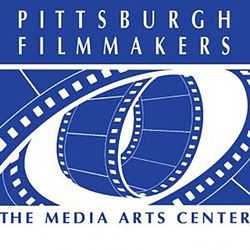Pittsburgh Filmmakers
| Pittsburgh Filmmakers | |
|---|---|
|
Pittsburgh Filmmakers logo | |
 Location within Pittsburgh | |
| Established | 1971 |
| Location | Pittsburgh |
| Coordinates | 40°27′21″N 79°57′13″W / 40.455971°N 79.953664°W |
| Website | http://pfm.pittsburgharts.org/ |
Pittsburgh Filmmakers is one of the oldest and largest media arts centers in the United States.
This non-profit institution in Pittsburgh, Pennsylvania began as a filmmaking-equipment access cooperative in 1971. That co-op is still a pillar of the organization, which now also includes an accredited school, three theaters (The Harris in the downtown Cultural District, the Regent Square in the neighborhood of the same name, and the Melwood Screening Room in North Oakland, located in the same building as the school) and the Three Rivers Film festival.
In January 2006, following votes by the Pittsburgh Filmmakers membership, Pittsburgh Center for the Arts board and Pittsburgh Filmmakers board, the merger of the two organizations became final. The Pittsburgh Filmmakers by-laws were carried over as the by-laws of the merged organization.
In Fall 2010, the combined Pittsburgh Filmmakers/Pittsburgh Center for the Arts entered into merger discussions with the Pittsburgh Glass Center.[1] By May 2011, the talks had failed, with the Pittsburgh Glass Center withdrawing from negotiations.[1]
The Crumbling Wall
The Crumbling Wall was a non-denominational coffeehouse run by the Lutheran Church on Forbes Avenue, across from Carnegie Library of Pittsburgh. The proximity of these two places is interesting, because both were to play a part in the development of Pittsburgh Filmmakers. A variety of programs were presented at The Crumbling Wall, including experimental films programmed by Chuck Glassmeyer. A group of interested people developed around these screenings, and soon they wanted more, including making their own films.
Foray into 16 mm
This incipient "scene" intensified in 1970, when Leon Arkus and Sally Dixon started the Section (later Department) of Film and Video at Carnegie Museums of Pittsburgh. Dixon started bringing artists into town to screen their work. It soon seemed like a natural development that if the artists were here, they should be able to work on their films. She acquired a grant to purchase 16 mm filmmaking equipment to this end.
Phase 1
The group found a space in the basement of the now-defunct Selma Burke Arts Center in East Liberty. The general shape of Pittsburgh Filmmakers as it exists today was already taking form then. The building included darkrooms and filmmaking facilities. Workshops in the use of equipment, as well as screenings, were offered. The early presence of photography is attributable to the fact that one of the energizing forces in the development of Filmmakers was photographer Robert Haller, later an executive director of Pittsburgh Filmmakers, and now Director of Library Collections at Anthology Film Archives in New York City.
Phase 2
In 1971, a more formal organization was formed. Articles of incorporation were filed and the name Pittsburgh Filmmakers was adopted. Bob Costa was the first director and Robert Gaylor, a successful designer, the first president of the board of directors. Space, and a lack of it, became an issue. In 1974, the University of Pittsburgh offered Filmmakers a space in an empty building at 205 Oakland Avenue. Its location in the heart of the university district was ideal. Pittsburgh Filmmakers began to slowly grow. By 1992, Pittsburgh Filmmakers was operating four buildings—the equipment facility at 205 Oakland, a classroom and editing facility at 218 Oakland, administrative offices around the corner at 3712 Forbes, and the Theater Annex in the historic Fulton Building at 101 Sixth Street downtown. The staff had grown by this time from one to 18 full-time, 8 part-time, and varying numbers of work-study students. Charlie Humphrey, the current executive director, began his tenure at this time. His predecessors include Robert Costa (1971), Phil Curry (1971-1973), Robert Haller (1973-1979), Marilyn Levin (1979-1983), Bob Marinaccio (1983-1987), Jan Erlich-Moss (1987, interim), Tony Buba (1988, interim), Margaret Meyers (1988-1991), Kurt Saunders (1991-1992, interim), Marcia Clark (1992), and the current director of education Brady Lewis (1992, interim).
Modern Times
Humphrey and his director of administration Dorinda Hughes, mounted a successful campaign starting in 1993 to modernize and unify the facilities. By the summer of 1995, Pittsburgh Filmmakers was ensconced in its current home at 477 Melwood Avenue, a 44,000-square-foot (4,100 m2) space formerly used as Carnegie-Mellon University's Tartan Labs. Renovations included the building's first floor—to house equipment, classrooms, darkrooms, and offices—and the 130-seat Melwood Screening Room.
In 1995, the owners of the Fulton Theater Annex asked Filmmakers to move out. A temporary home for the Theater Annex's exhibition program was found at Point Park College's facility on Craft Avenue in Oakland. Before year's end, it moved into the Harris Theater at 809 Liberty, a former X-rated movie house located in downtown Pittsburgh. In early 1998, Pittsburgh Filmmakers purchased the Regent Square Theater, at 1035 South Braddock. In 2001, rehabilitation of the second floor of 477 Melwood was completed, which now holds offices, digital editing suites, classrooms, a sound stage, a new gallery for photo and other exhibitions, and a 60-seat theater. Aside from its rich and interesting history, it offers a superior quality education and exploration of the film medium in general.
External links
| Wikimedia Commons has media related to Pittsburgh Filmmakers. |
- Pittsburgh Filmmakers: The Media Arts Center
- Robert Haller book on 1970s experimental film in Pittsburgh
- PFMI 1981 article
References
- ↑ 1.0 1.1 Tascarella, Patty (May 31, 2011). "Pittsburgh Filmmakers, Pittsburgh Glass Center cancel merger talks". Pittsburgh Business Times. Retrieved February 15, 2013.
